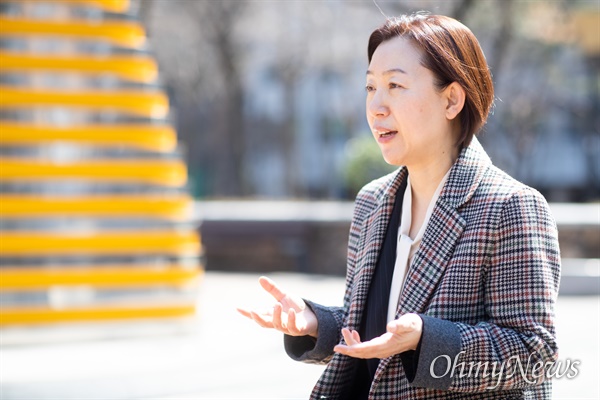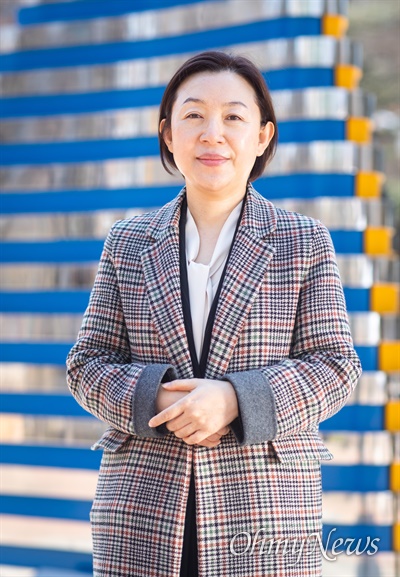| Since the first confirmed case on January 20th in Korea, the whole nation has been suffering from the COVID-19 for 2 months by the upcoming March 19th. OhmyNews diagnoses the current spread of COVID-19 with the analysis of deaths, timelines and re-meeting experts on the issue.[편집자말] |
큰사진보기

|
| ▲ Prof. Ki Moran at National Cancer Center Korea |
| ⓒ Lee Hee Hoon | 관련사진보기 |
We asked straightforwardly to Ki Moran, a professor at the National Cancer Center(Head of the Task Force for COVID-19 at The Korean Society for Preventive Medicine)
- With the extension of delaying daycare centers opening, parents who take care of their children at home are complaining of difficulties.
"No wonder they're having a hard time. But if we open the centers now, COVID-19 will continue."
When she sat face to face with the reporter on February 12th, Prof. Ki Moran criticized the closure of daycare centers as an "unscientific decision." There was not a single confirmed case on that day, and by then the cumulative confirmed cases were only 28 patients. We met Prof. Ki Moran again about a month later and she said, "The school should be closed for some time more, and it will be difficult for the school to open on April 6th."
"In the stage of spreading community infection, schools can be an important link to the community infection. It is more problematic because there are no major symptoms in children. Children are at risk of spreading COVID-19 and having parents or grandparents infected. In that case, the fatality rate will be very high. Also, parents can be the links to spreading the infections to their companies and the communities."
Throughout the interview, Prof. Ki emphasized social distancing several times. What will happen if social distancing is loosened? Professor Ki warns that "endemic is coming." Endemic refers to a situation in which COVID-19 does not end, but like a cold, it remains with us and occurs periodically. The results she analyzed about COVID-19 spread in Seoul and Gyeonggi-do Province were the same.
Professor Ki Moran, a preventive medicine doctor, is one of the most sought-after COVID-19 experts among government agencies and the media in Korea. Recently, foreign media such as The New York Times have contacted her. She also agreed to participate in a joint study between WHO and Korea's COVID-19 research center. The reporter met her at the park in front of a broadcasting station in Mokdong, Seoul, last Wednesday afternoon. Thanks to the warm weather, there were a lot of people in the park.
"The distance (between the reporter and me) is rather close, but it's okay to be more than two meters away in the outdoors."
Will COVID-19 End This Year
큰사진보기

|
| ▲ Prof. Ki Moran at National Cancer Center Korea |
| ⓒ Lee Hee Hoon | 관련사진보기 |
Professor Ki Moran released a prediction of the future COVID-19 spread in Daegu and Gyeongsangbuk-do Province through mathematical modeling on March 12th. Mathematical modeling for infectious diseases is to predict the spread by utilizing differential equations and so on.
According to Professor Ki Moran's analysis of the confirmed number of cases from Feb. 18th to March 4th, when the first patient in Daegu(the 31st patient) was identified, the reproductive number was higher than 3. If the reproductive number is 1, it means one COVID-19 patient infects one person, and the trend of COVID-19 remains. Only when the reproductive number is less than 1, will the number of confirmed cases decrease. The reproductive number can be lowered through social distancing.
Professor Ki has prepared five scenarios, of which 'Scenario 5' fits the current situation. According to the scenario, April 10th will be the day when the number of confirmed cases in Daegu and Gyeongsangbuk-do Province is less than 10 per day. And May 1st is the day the number of confirmed cases will be less than one case a day. The total number of patients will be 10,249. As of midnight on March 19th, the confirmed cases in Daegu and Gyeongsangbuk-do Province are 7,431. Therefore, it is predicted that 2,800 more will be infected. The basic premise of this scenario is that there is no COVID-19 inflow from other areas apart from Daegu and Gyeongsangbuk-do Province.
- Is the current situation going like Scenario 5?
"The increase rate of the confirmed cases has decreased faster. Under the current situation, the total number of patients could be between 8,000 and 9000. This is the result of people working harder at social distancing."
- Group infections continue to occur in the Seoul area.
"I haven't received Incheon data yet, so I analyzed it with the data only from Seoul and Gyeonggi-do Province. Unlike Daegu and Gyeongsangbuk-do Province, I did mathematical modeling on the assumption that there are the external inflows in Seoul and Gyeonggi areas, and the reproductive number is 0.8."
- If so, doesn't it mean the spread of COVID-19 will decrease in the Seoul metropolitan area as well?
"It doesn't decrease much. The reproductive number must fall below 0.5 for COVID-19 to be fully terminated. (On Feb. 12th, when we did the first interview), the total number of confirmed cases was only 28, and the reproductive number was 0.5. Since 0.8 is close to 1, the trend continues. It won't end completely."
- Does it mean we can't terminate COVID-19 for good?
"That's the scenario we're worrying about because if the reproductive number stays between 0.8 and 1, COVID-19 becomes indigenous. It's called endemic, which means there's always a certain amount of patients."
- Then, will COVID-19 become like the flu or a cold?
"The flu is a seasonal epidemic that comes back in time. But a cold is endemic that occurs all year round. Of the six types of coronavirus, excluding SARS and MERS, 4 types remain like a cold. COVID-19 has a high fatality rate for the elderly as it is easy to transmit. While the elderly don't die from a cold or the flu in nursing homes, many people die when COVID-19 goes around. Also, unlike the flu, there is no cure or vaccine for COVID-19."
- No matter what we do, we have to prevent COVID-19 from being endemic, right?
"Can we wipe it out completely? I think it will be very difficult if the whole world doesn't try very hard. China, which has seen a significant drop in the number of confirmed cases, is also not able to relax. Although MERS is said to have ended in Korea, about 100 people who have been to the Middle East are treated as suspected MERS patients every year. COVID-19 has much greater spreading power than MERS."
- When do you think it will end globally?
"There is a high possibility that it will not end within this year. The world experienced two pandemics so far, which were the influenza pandemics, including the Hong Kong flu and the swine flu. They started at the same time and ended simultaneously. However, the Covid-19 pandemic is like a domino. Even if COVID-19 ends in Korea, it is not over. It can go around in other countries like dominoes and then come back to our country again."
When Can We Have Our Normal Lives Back
큰사진보기

|
| ▲ Prof. Ki Moran at National Cancer Center Korea |
| ⓒ Lee Hee Hoon | 관련사진보기 |
Prof. Ki Moran stressed that social distancing is more important than ever. What would she say about the government's extension of delaying the opening of daycare centers, kindergartens, and all schools to April 5th? This is what she said.
"The stage of COVID-19 crisis warning is now in 'Serious' level and in the state of spreading community infection. So, closing schools is a must. Schools can be an important link to the community infection. It is more problematic because there are no major symptoms in children. Children are at risk of spreading COVID-19 and having parents or grandparents infected. In that case, the fatality rate will be very high. Also, parents can be the links to spreading the infections to their companies and the communities."
- Then, do you think school can start on April 6th?
"April 6th is also likely to be difficult. To be able to open the school at that time, the number of confirmed cases per day in the whole country must fall to a single digit. Also, the confirmed person must be someone we can track or in self-quarantined. At this rate, the COVID-19 crisis warning will be 'Alert' level. Otherwise, if a newly confirmed person is either unaware of the route of infection or works at a nursing home, COVID-19 will be spreading wildly."
- Up until last week, there were hundreds of confirmed cases a day, but more recently there are fewer than 100. In two weeks, don't you think COVID-19 will die down?
"If COVID-19 was our own situation, we could think so. But there's been increasing inflows from abroad, and also the confirmed cases occur with silent infections."
- With the extension of delaying daycare centers opening, parents who take care of their children at home are complaining of difficulties.
"No wonder they're having a hard time. But if we open the centers now, COVID-19 will continue."
- Should we practice social distancing more thoroughly than now?
"We have to practice it more thoroughly for the next two weeks than now. Giving an administrative order, the government has to ban all gatherings at any cost to lower the number of confirmed cases to the single digits a day. Since they recommend not gathering, collective infections have occurred in churches and call centers. Also, if children go to singing rooms or PC rooms, confirmed cases will occur continuously. It's a disaster if a confirmed person spreads the infection to his or her coworkers and family in the community, while the quarantine authorities are chasing them around to put out the fire."
- People are getting tired of social distancing more and more.
"It would be nice if we did it perfectly for two weeks, but it keeps getting longer because we can't do that. Now, so many citizens are actively joining it. However, some deviations do not end the situation. While the participants of social distancing are getting tired, if a group infection comes out one by one, it never ends. In fact, we (the researchers) joked when COVID-19 first started. We said, 'We know the answer. It will end when people around the world are stuck at home for two weeks.' Now that I see it, things have got this worse because we didn't do it."
When we did the interview, the temperature in Seoul rose to 17℃, showing the perfect spring weather. There were many children in the park with their parents. Will outdoor activities be okay? She said, "It's okay to be out. Even if you cough, the droplets don't go to anyone 2m away."
At the end of the interview, the reporter asked her the most curious question in his mind. 'Can we be able to return to normal in a month or two?' However, the answer was somewhat different from what he expected.
"We should continue practicing social distancing until COVID-19 spreading ends around the world. I don't think it will end this year. Even if the daily confirmed cases are reduced to a single digit in Korea and the school door is reopened, our daily life at school and at work should be different from usual."
Written by Sun Dae Sik
Photo by Lee Hee Hoon
Translated by Youngae Joanna Kim.
* This report is the English version of OhmyNews Korean article. If you want to read the original article in Korean, click here!